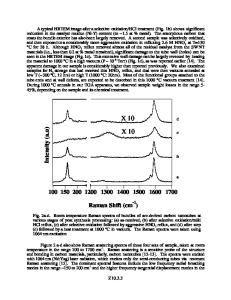Tailoring singlewalled carbon nanotubes for hydrogen storage
- PDF / 2,440,668 Bytes
- 10 Pages / 612 x 792 pts (letter) Page_size
- 2 Downloads / 370 Views
Hydrogen isotherms on a variety of single-walled carbon nanotube (SWNT) samples were measured using a differential pressure adsorption apparatus, which provides highly accurate data. A number of these SWNT samples were modified by a non-destructive cutting process, which reduced the aspect ratio of the nanotube bundles by two orders of magnitude. There were no apparent differences in the microporosity of SWNT as a function of aspect ratio. The adsorption of helium on SWNT is shown to be non-negligible and results in artificially low hydrogen capacities using conventional adsorption methodology. With no accounting for helium adsorption, the hydrogen adsorption results show that cut and uncut SWNT have similar hydrogen capacities of cut SWNT > uncut SWNT. Also, from the initial slope of the isotherm (which would correspond to a Henry’s law constant), the activated carbons and cut SWNT appear to have a greater affinity for H2 than the uncut SWNT. It is clear from the 25 °C measurements that the studied SWNT materials whether cut or uncut do not show, as may have been expected, improved H2 sorption characteristics with respect to conventional high surface area activated carbons. While absent in these room temperature results, the effect of changing the SWNT aspect ratio does, however, seem to manifest itself in the adsorption of hydrogen at cryogenic temperatures both in terms of the affinity and the capacity of these sorbents for hydrogen. One tentative explanation for this dichotomy between the 25 °C and 77 K results may be couched in terms of a temperature-dependent access of hydrogen to adsorption sites. At 77 K, there is a clear affinity and 3220
http://journals.cambridge.org
capacity resolution between cut and uncut SWNT, which implies the presence of a greater density of higher energy H2 adsorption sites for the former, as might be expected for a “fractured” material. We suppose on the other hand that at 25 °C the H2 is now kinetically accessible to much more of the inherent pore volume of the adsorbents so that now there is little or no discernment in H2 capacities with respect to aspect ratio. Although the SWNT sorption data measured with the assumption of negligible helium adsorption reveal relatively low H2 sorption capacities, an interesting trend emerges when one compares the equilibrium loading of these SWNT relative to activated carbons as a function of N2 Brunauer–Emmett–Teller (BET) surface area. In previous studies, the hydrogen capacity of various carbon materials has been shown to be a function of micropore volume.45 In Fig. 13, we examine the relationship between hydrogen capacity (at 25 °C and 107 bar) and N2 BET surface area. Hydrogen adsorption capacity on carbonaceous materials is often claimed to be a function of sample surface area regardless of the type of carbon.46 The results in Fig. 13 do not support this common belief. Our hydrogen capacity versus surface area data reveal two distinct trends: one for planar (activated) carbons and a second for carbons with curved surfaces, specifically
Data Loading...











